Guide to U.S. Coins
Learn about United States Coins – from classic U.S. coins to modern coins
Hold one of these coins in your hand and travel back in time. A silver 3¢ piece recalls the Civil War, while the Peace dollar echoes the glitz and glamour of the Roaring Twenties. Genuine U.S. coins not only blaze a path through America's history – they tell the country's story in a way that few other artifacts can. Why? Since our nation's beginnings, George Washington, Thomas Edison, our grandparents, parents, and even you today, have used coins!
The following is a guide to United States coinage that outlines the major design types by denomination and date of issue.
Half Cent 1793-1857
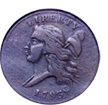
Liberty Cap
1793-1797
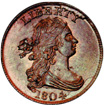
Draped Bust
1800-1808
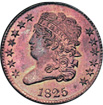
Classic Head
1809-1836
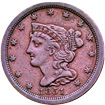
Braided Hair
1840-1857
The smallest denomination, yet nearly the size of a modern quarter. Made of pure copper, the half cent was useful for making change during its early years of issue. But as time passed and things grew more expensive, the half cent lost its usefulness, and was abandoned shortly before the Civil War. Today, all half cents are scarce. All types carry a bust of Liberty on the obverse and a wreath on the reverse.
Large Cent 1793-1857
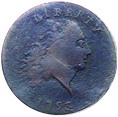
Flowing Hair
1793
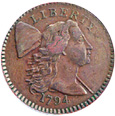
Liberty Cap
1793-1796
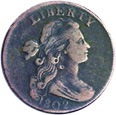
Draped Bust
1796-1807
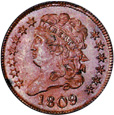
Classic Head
1808-1814
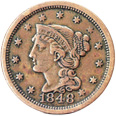
Modified Liberty head
1816-1857
Along with the half cent, one of the first two coins struck by the United States, all the large cents were coined at the Philadelphia Mint. With twice the copper of the half cent, they were large and heavy – greater in size than today’s quarter – so a pocketful was quite bulky. As the price of copper rose during the 1800s, the large cent became too expensive to produce and was replaced in 1857 by the small cent.
Small Cent 1856-Date

Flying Eagle
1856-1858

Indian Head
1859-1909

Lincoln
1909-Date

Lincoln - Wheat Ears Reverse
1909-1958

Lincoln - Memorial Reverse
1959-2008

Birthplace
2009 Reverse

Formative Years
2009 Reverse

Professional Life
2009 Reverse

Presidency
2009 Reverse

Union Shield Reverse
2010-Date
America’s first small cent, the Flying Eagle, was introduced in 1856. It was nicknamed the “white cent” because of its 88% copper and 12% nickel composition. Designed by James Longacre, the Flying Eagle cent was minted for just 3 years before being replaced with the Indian Head cent.
In 1909, the Lincoln cent became America's first to portray a president. It originally featured the "Wheat Ears" reverse design, which was changed to the Lincoln Memorial in 1959. Then, for the series' 100th anniversary and the bicentennial of Lincoln's birth in 2009, four different reverse designs were released. A new, ongoing reverse design featuring the Union Shield debuted in 2010.
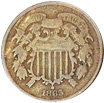
Two-Cent Piece
1864-1873
Two-Cent Piece 1864-1873
The 1864 Coin Act also called for a 2¢ copper coin. This Civil War-era coin was America’s first and only 2¢ piece. It was the first coin to carry IN GOD WE TRUST.

Silver Three-Cent Piece
1851-1873
Silver Three-Cent Piece 1851-1873
The 3¢ piece is the smallest of all U.S. silver money. Because it was struck in silver, the public hoarded it along with other coins when the Civil War broke out. Since the 3¢ piece was needed to help ease the shortage caused by war, the U.S. Mint decided to strike it in copper-nickel.

Nickel Three-Cent Piece
1865-1889
Nickel Three-Cent Piece 1865-1889
The 3¢ nickel, so called because of its copper-nickel composition, was well received by the public. This helped the nation retire the unpopular 3¢ paper notes issued during the Civil War. Once the majority of notes had been exchanged for 3¢, and production of 5¢ nickels and cents increased, the banks needed fewer 3¢ pieces.
Nickel 1866-Date

Shield
1866-1883

Liberty Head
1883-1913

Indian Head or Buffalo
1913-1938

Jefferson
1938-2004

Jefferson
2005 Obverse

Peace Medal
2004 Reverse

Keelboat
2004 Reverse

Buffalo
2005 Reverse

Ocean in View
2005 Reverse

Jefferson
2006-Date
In 1866, the nation’s first 5¢ coin of non-precious metal was created: the Shield nickel. The prior (and first) U.S. 5¢, the half dime, was silver. In 1883 came the Liberty Head or “V” nickel, followed by the extremely popular Buffalo nickel of the early 20th century, and then the long-running Jefferson nickel. In 2004, new Westward Journey Jefferson nickels were released. Commemorating the Bicentennial of the Lewis & Clark expedition, two new reverse designs were issued annually. In 2006, the popular series ended with the “Return to Monticello”.
Half Dime 1794-1873

Flowing Hair
1794-1795

Draped Bust
1796-1805

Capped Bust
1829-1837

Liberty Seated
1837-1873
Minted in fine silver, the famous half dime was the nation’s first 5¢ coin. It was smaller and weighed less than a nickel. Several design types were issued long before the U.S. nickel denomination began. From 1866-1873, both the half dime and nickel were struck. The half dime played an integral role in the early life of America, and is of great historic and numismatic importance.
Dime 1796-Date

Draped Bust
1796-1807

Capped Bust
1809-1837

Liberty Seated
1837-1891

Barber or Liberty Head
1892-1916

Winged Liberty Head or "Mercury"
1916-1945

Roosevelt
1946-Date
The 10¢, or dime, follows closely the designs of the half dime through the Liberty Seated type. And until 1964, when production of circulating silver coinage was ceased, all circulating dimes were minted in fine silver. Dimes in higher grades are scarce and expensive, since this denomination was used extensively compared to quarters and halves. But many early dimes are still available in circulated condition at a more reasonable cost.

Twenty-Cent Piece
1875-1878
Twenty-Cent Piece 1875-1878
The shortest-lived coin denomination in U.S. history! The twenty-cent piece, minted in 90% fine silver, was struck for circulation only in 1875 and 1876. A few hundred Proofs were coined in 1877-1878. Soon after, people complained that it was too close in design and size to the quarter – causing problems in making change. Fewer than 1.4 million were minted, so the twenty-cent piece is a scarce and treasured item today.
Quarter 1796-Date
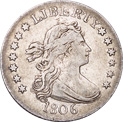
Draped Bust
1796-1807
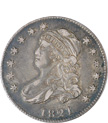
Capped Bust
1815-1838
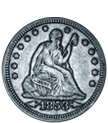
Liberty Seated
1838-1891
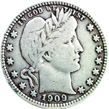
Barber
1892-1916
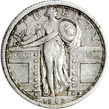
Standing Liberty
1916-1930
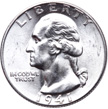
Washington
1932-1998
Because of the practice of cutting up the Mexican 8 Reales into eight parts (thus the “Piece of Eight” name), the U.S. quarter, as ¼ of a dollar, became known as “two bits.” As a silver coin of substantial size until 1964, the quarter has always been popular – both in circulation and among collectors. Several designs have been used since 1796, and many collectors try to assemble at least one of each type.
Statehood, D.C. & U.S. Territories 1999-2009
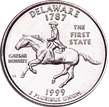
Delaware
1999
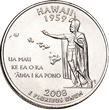
Hawaii
2008
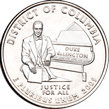
District of Columbia
2009
A new era of collecting began with the start of America’s 50 State Quarters Program in 1999. From 1999-2008, every state in the Union was honored in the order they joined, or, in the case of the 13 original colonies, the order they ratified the Constitution. In 2009, an additional six quarters were issued, honoring the District of Columbia and five U.S. territories.
National Park 2010-2021
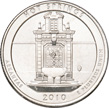
Hot Springs
2010
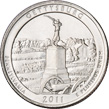
Gettysburg
2011
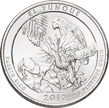
El Yunque
2012
In 2010 another series, modeled after the Statehood quarters, began – this time honoring America’s national parks and historic sites. Designs are scheduled to be released until 2021 for each of the 50 states, D.C., and the five U.S. territories in the order their locations first became national sites.
U.S. Women 2022-Date
The latest quarter series scheduled to run through 2025 features U.S. women whose accomplishments changed the course of American history. The new Washington obverse was submitted in the original 1931 competition by sculptor Laura Gardin Fraser.
- See our complete Quarter Release Schedule
- Learn more about Quarters |
- Back to top
Half Dollar 1794-Date
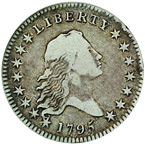
Flowing Hair
1794-1795
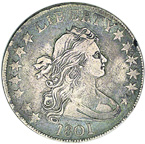
Draped Bust
1796-1807
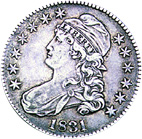
Capped Bust
1807-1839
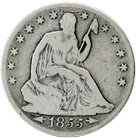
Liberty Seated
1839-1891
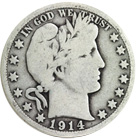
Barber or Liberty Head
1892-1915
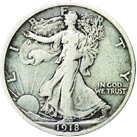
Liberty Walking
1916-1947
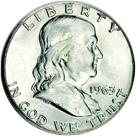
Franklin
1948-1963
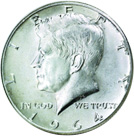
Kennedy
1964-Date
Though the half dollar is almost forgotten today, it was once the major silver coin of circulation. At one time, a half dollar was often more than a person made in a day’s labor. To have one, or perhaps two, was a significant stash of money. Because the half dollar is seldom seen today, it continues to grow in popularity.
- Learn more about Early Half Dollars or Modern Half Dollars
- Back to top
Dollar 1794-Date
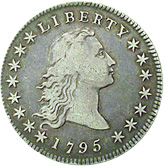
Flowing Hair
1794-1795
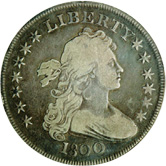
Draped Bust
1795-1804
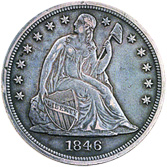
Liberty Seated
1840-1873
Early silver dollars represent the remarkable era in America’s history when the colonies united to form what would become one of the greatest nations on Earth. Since precious silver ore was scarce in that era, the dollars of that period have very low mintages. Silver dollars were not minted between 1804 and 1836, so those that still circulated were scarce and hoarded. In addition to the early dollars pictured, a number of so-called “Gobrecht” dollars were issued between 1836-1839, and served as patterns for the Liberty Seated dollar.
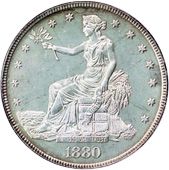
Trade
1873-1885
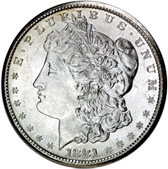
Morgan
1878-1921
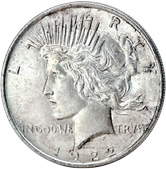
Peace
1921-1935
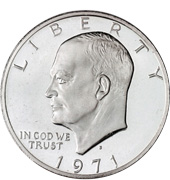
Eisenhower
1971-1978
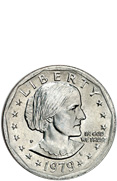
Susan B. Anthony
1979-1981, 1999
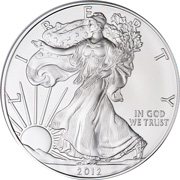
American Eagle
1986-Date
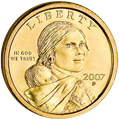
Sacagawea
2000-2008
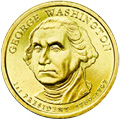
Presidential
2007-Date
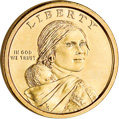
Native American
2009-Date
The U.S. dollar of the late 19th century to the present are among the most sought-after collector issues. These include Trade, Morgan, and Peace dollars struck in 90% silver, as well as the Eisenhower dollars, which were the last large-size $1 coins struck for circulation. Susan B. Anthony began a new era of small-size U.S. dollars, and were followed by the Sacagawea dollars of 2000 to 2008, and the new Presidential dollar series introduced in 2007. Though originally issued for circulation, beginning in 2012 the Presidential dollars were issued in limited quantities for collectors only.
In 2009, new Native American dollars debuted, with the familiar Sacagawea obverse (with date and mint mark moved to the edge) and annually changing reverse designs. The $1 American Eagle silver bullion issues, struck in 99.93% silver, were introduced in 1986 and are the largest of all U.S. money.
- Learn more about Early Dollars or Modern Dollars
- Back to top
U.S. Gold Coins

Liberty Head $1 Gold
1849-1854

Indian Head $2.50 Gold
1908-1929
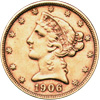
Liberty Head $5 Gold
1839-1908
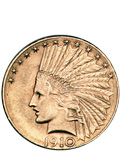
Indian Head $10 Gold
1907-1933
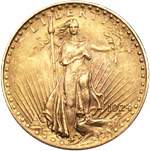
Saint‑Gaudens $20 Gold
1907-1933
Between 1795 and 1933, the U.S. Mint produced various gold coins in the denominations of $1, $2.50, $3, $5, $10 and $20 (plus a few extremely rare $4 pattern pieces). These were minted in one of the world’s most precious metals, and designed by some of the finest artists of the day. Mintages were quite small, and many have been melted down over the years, so U.S. gold are of particular scarcity and interest today. Since 1986, American Eagle gold bullion have been issued just for collectors. For many, gold bullion with their unmatched beauty and worldwide popularity represent the apex of enjoyment in numismatics.
U.S. Commemoratives
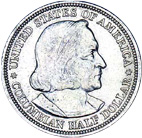
1892 Columbian Half Dollar – the first U.S. Commemorative
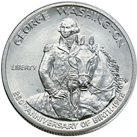
1982 George Washington Half Dollar
Official U.S. commemoratives are authorized by Act of Congress to honor important persons, locations, and events in U.S. history. Commemoratives have been struck in both silver and gold, and more recently, clad. They are minted only in very small numbers compared to regular coinage. After 1954, no U.S. commemoratives were produced until 1982, when the George Washington half dollar was issued to commemorate the 250th anniversary of Washington’s birth. Official U.S. issues should not be confused with so-called “commemoratives” produced by private organizations, which are medals.

